KI and interesting facts
As I mentioned in yesterdays post, this morning we were off to Kangaroo Island on the 8:30 ferry. What I did not mention was that we had booked to pick up a day long bus tour once off the ferry. The hope was that the bus tour would give us an overview of Kangaroo Island since we did not have the time in our schedule to spend days touring by ourselves.
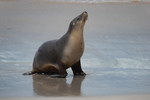
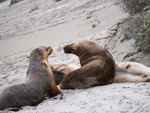

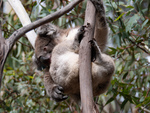

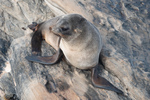
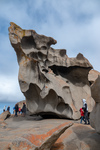
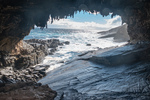
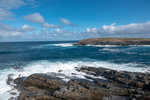
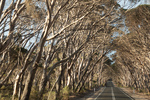
Kangaroo Island was named by Mathew Flinders (a name that crops up everywhere in southern Australia). He chose the name because he found the local kangaroos to be so unafraid of humans that his men could hunt them for meat by simply walking up and grabbing them. The island is about 150 km long and 50 km wide (though only 1 km at its narrowest point) and about the same land area as Singapore but with a population of about 4,500.
KI (as the locals call it) has been separated from the Australian mainland for some thousands of years and it is estimated that aboriginal peoples have not lived on KI for at least 4000 years. Although there is definite evidence of older aboriginal habitation.
Isolation from the mainland, and its generally colder climate than the mainland has resulted in some interesting changes in some of KI's animals.
For example, the KI Tiger snake unlike its mainland cousin does not have colored bands but rather is a uniform darker color presumably so that it can more successfully soak up the suns warmth.
The local goanna population (a large lizard) bury thier eggs in termite mounds which incubate the eggs because the termites maintain a constant temperature in their mounds. After hatching the young goannas live for about 5 months inside the mounds eating the termites as their only source of food. In most of Australia the climate is warm enough that mother goannas only have to bury their eggs in the ground or forest floor litter.
The bus tour turned out to be very successful, a comfortable bus, with clean windows, a sound system that worked, but most importantly a driver/guide who spoke clearly and imparted a wealth of wonderfully obscure facts (some of which I have already related).
The most interesting obscure fact of the day was an explanation of an Echidna Train. The Echidna is a small spikey animal a bit like a porcpine. The Echidna is a very unusual animal, it is a mammal, but it gives birth by laying a soft shell egg into a pouch on its underside. Once in the pouch the egg eventually hatches and the young echidna developes further inside the pouch. The Echidna is a burrowing animal so in order that a mothers pouch does not fill with dirt while it is burrowing the pouch faces backwards.
When breeding time comes around male echidnas seek out a female and follow that female until it is time to mate. If (as often happens apparently) multiple males decide to follow the same female they follow in a line forming an Echidna Train as shown in the photo below. The photo is curtesy of Hamish Kennedy the driver/guide on our tour. Once the female is ready she stops and the males circle around her waiting for her to chose her mate. Apparently scienstist do not know on what basis she makes the choice.
The Koalas pictured are some of the estimated 50,000 Koalas currently living on KI. The number is a bit of a problem for the Koalas and the local National Parks people. The Koala is not native to KI, it was imported from Victoria in the 1930s. The trees that the KI Koalas live in and feed on (Tasmanian Blue Gums) are also not native. Why are 50,000 Koalas a problem; over grazing - too many for the food supply - overgrazing will eventually kill the gum trees that the koalas feed on thereby threatening the entire Koala population.
Again tonight we stayed at the Cape Jervis Caravan Park.